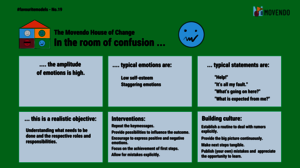#favouritemodel No.19 - House of Change - Confusion

Mostly, this phase of trying out is determined by changing and erratic emotions. A first courageous test of a new software, for example, can quickly turn into a feeling of disappointment and uncertainty when it does not immediately work as desired. Hope and frustration alternate.
In some cases, this is also accompanied by low self-esteem, as familiar paths in which employees felt secure and knew their way around well have to be abandoned. Instead, new behaviors have to be learned that don't come easily right away.
Typical statements heard more often in this space include: “What am I supposed to do now?”, “I just don't get it.”, “What have I done wrong?”, “Where is this all going?”, "Let's hire a consultant!“
How does this #favouritemodel help you?
The best way to support your employees in the "room of confusion" is to provide them with many opportunities for conscious learning loops. Especially during this time, it is normal and at the same time important that mistakes are (allowed to be) made and that you work through them constructively. Because as soon as new behavior is to be learned, it is quite natural that not everything goes perfectly from the start. You should encourage your team to experiment and share their experiences with each other.
At the same time, it helps your employees if they receive regular and quick feedback. Be sure to give positive feedback when things go right. This helps them to better understand the new guidelines. Small steps in the right direction and initial small successes should be regularly appreciated. Establish a regular meeting to discuss and reflect the changes and the experiences with it.
It is okay in this phase to repeat information about the goal and important milestones. Due to the high emotionality in this phase, people find it more difficult to concentrate on factual information. Through repeated, clear communication, you set the framework for change in the long term and help your employees get their bearings.











